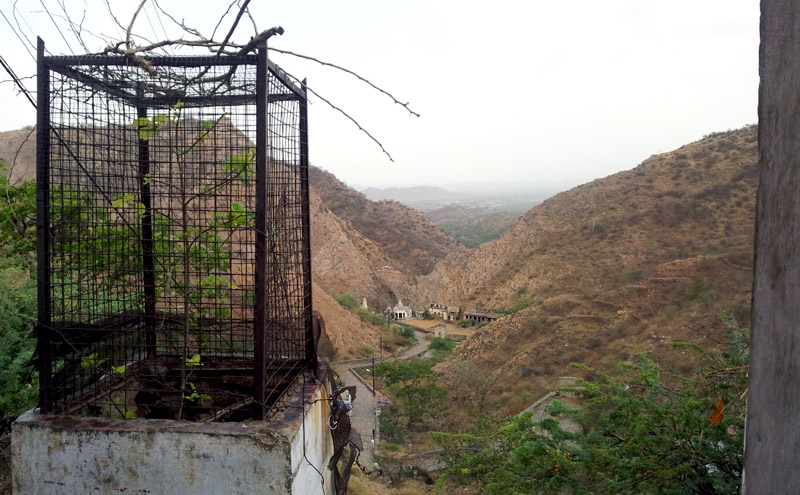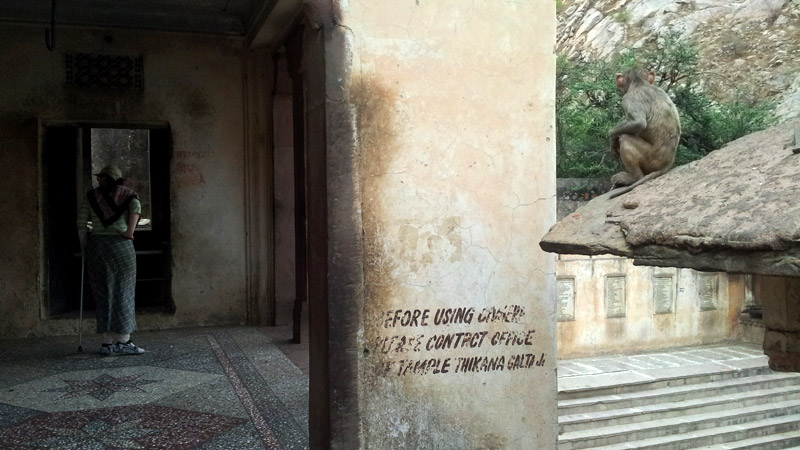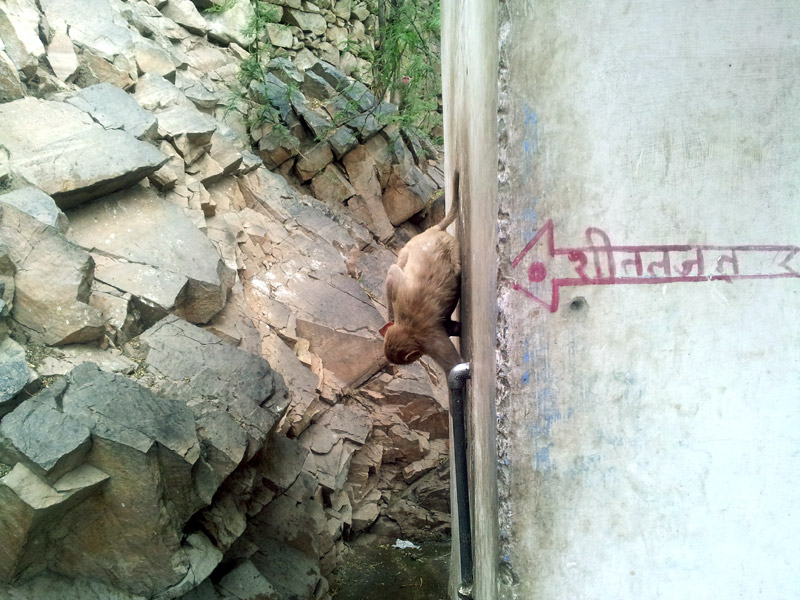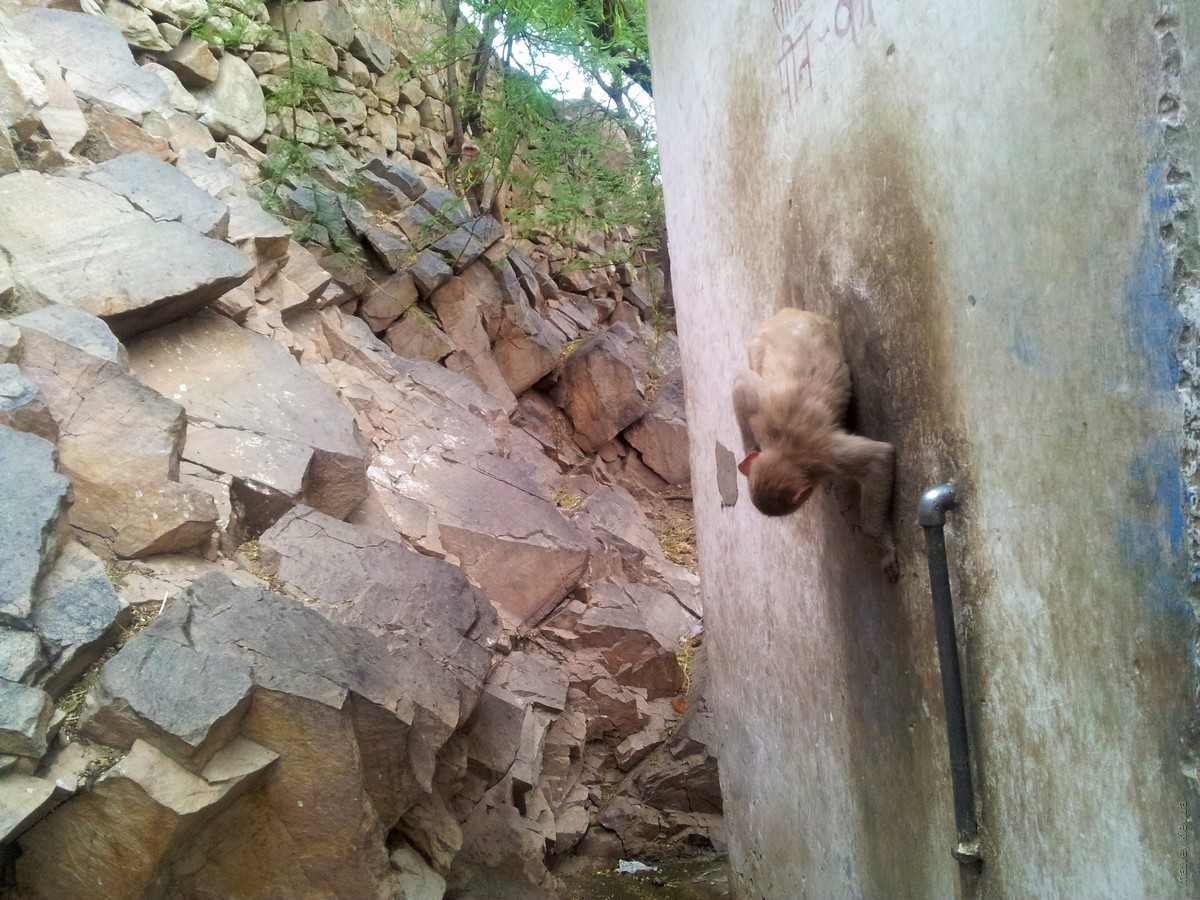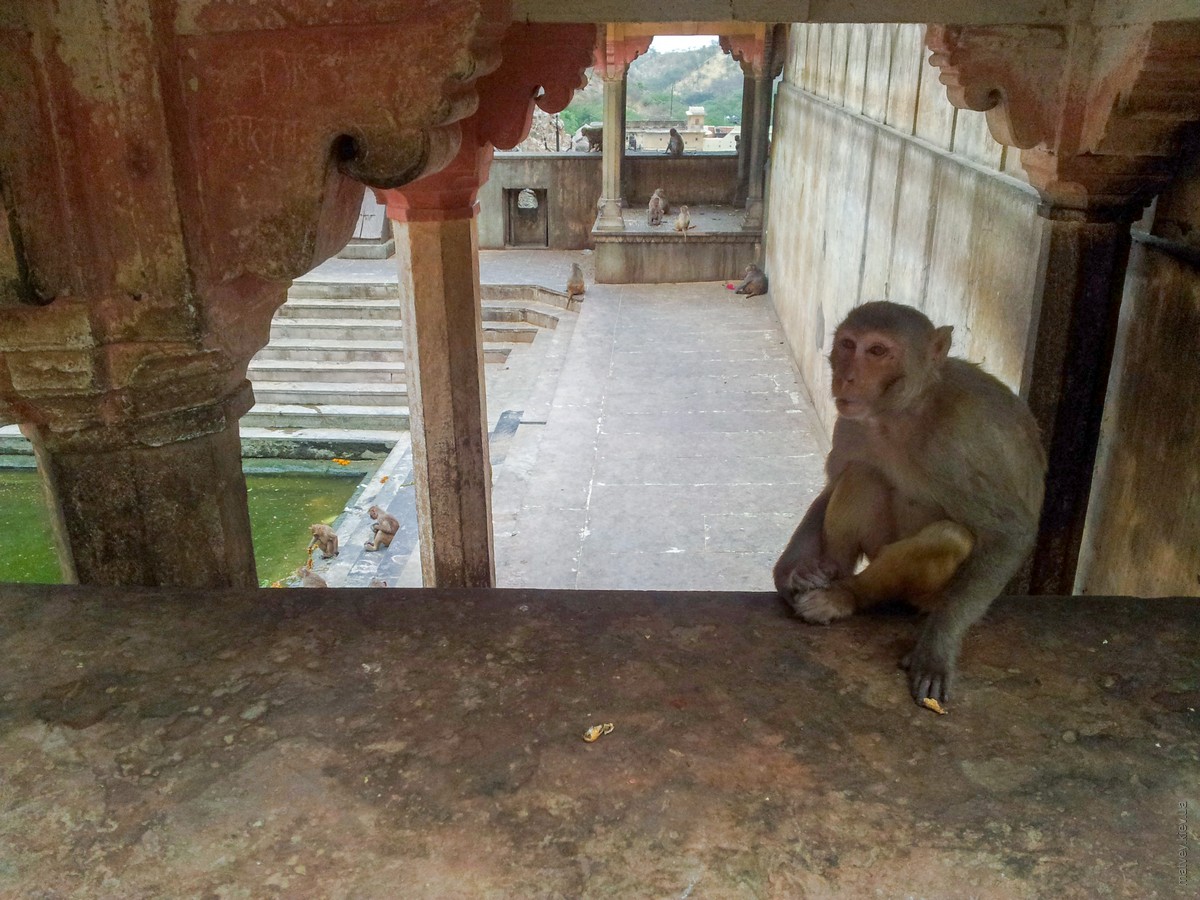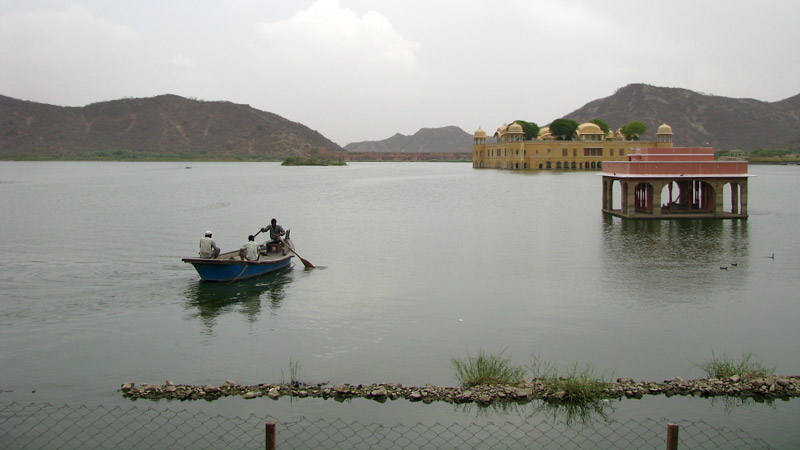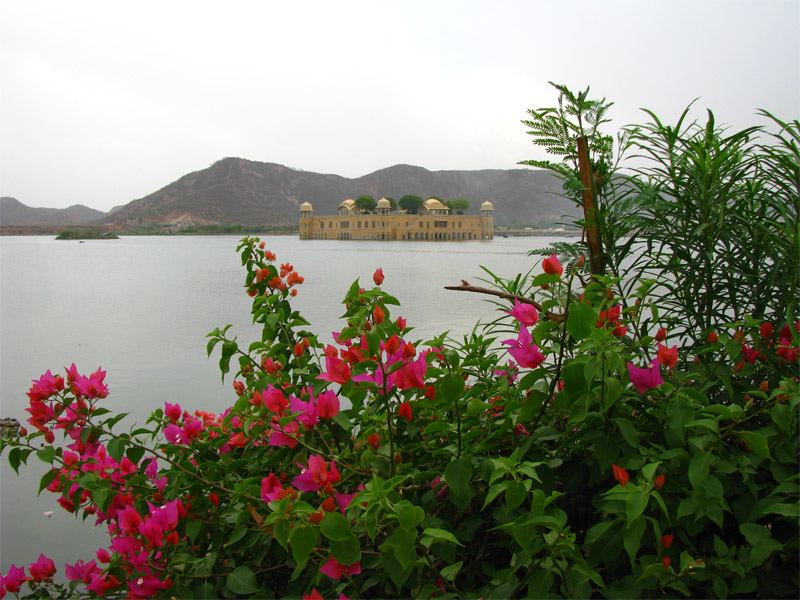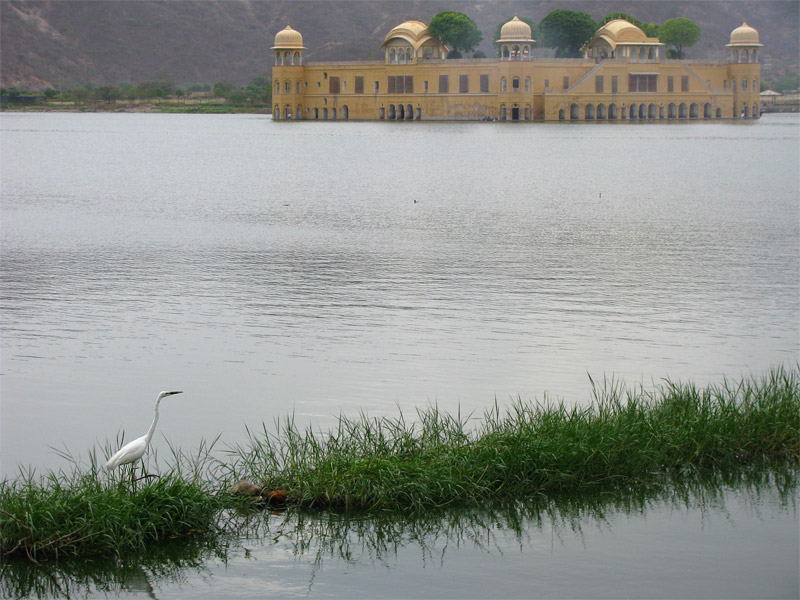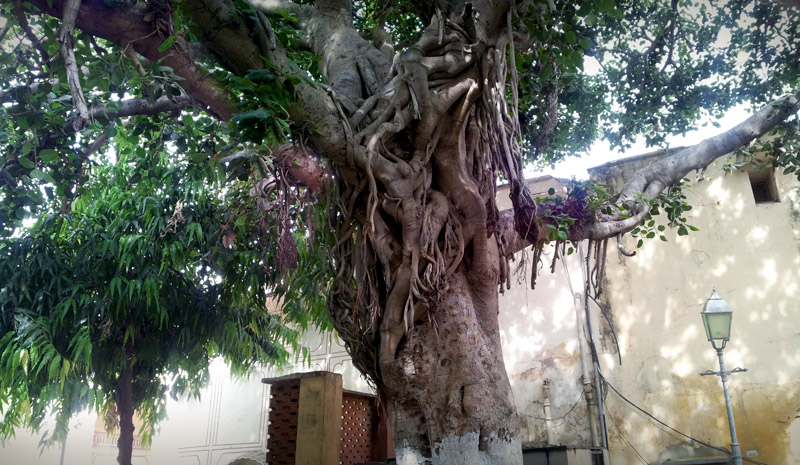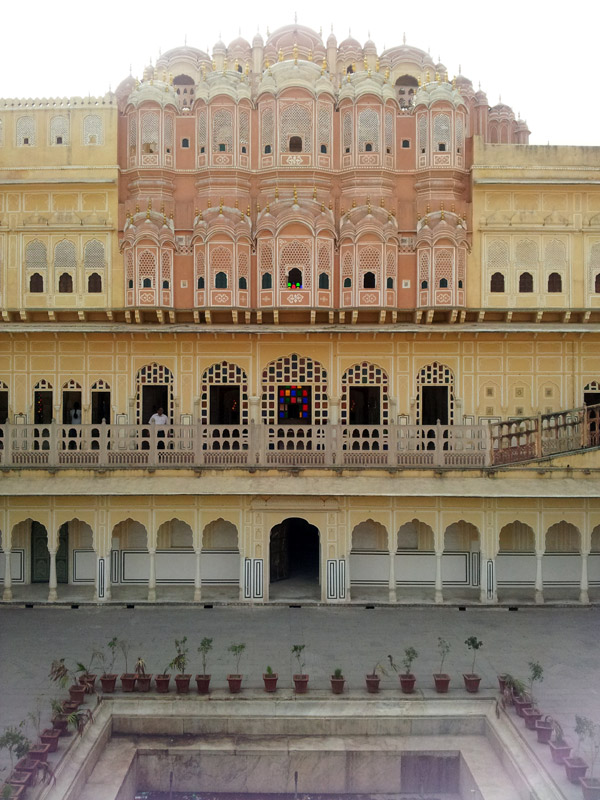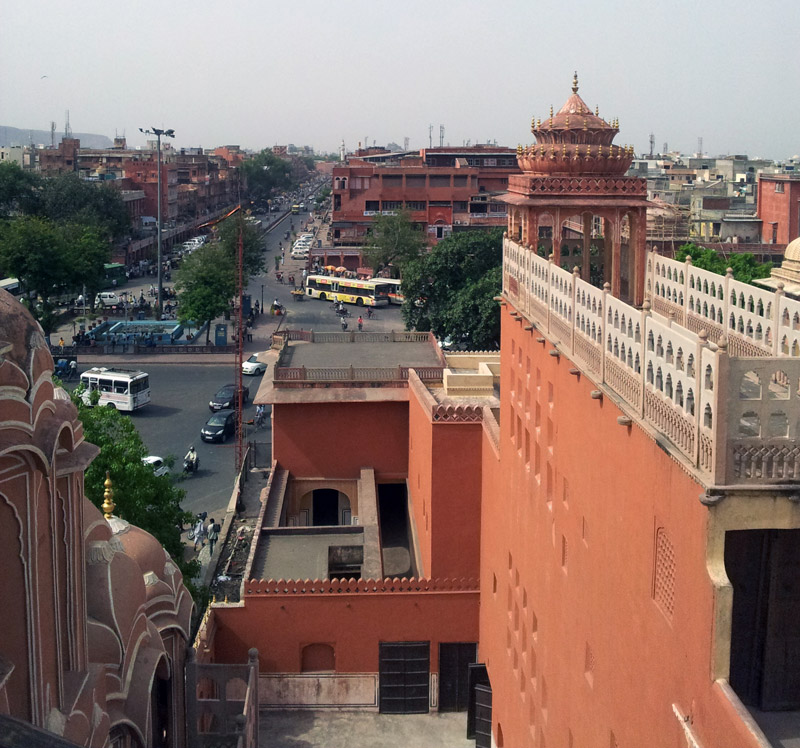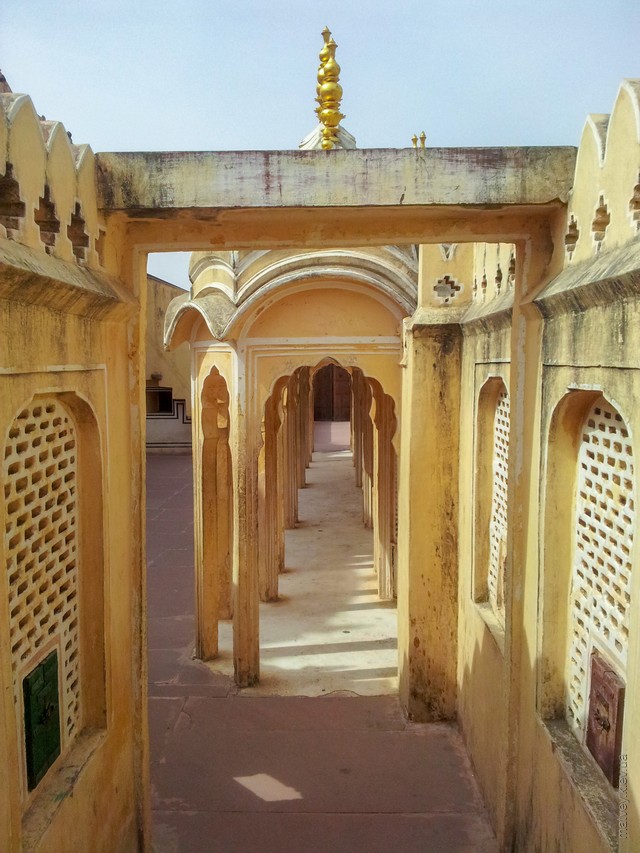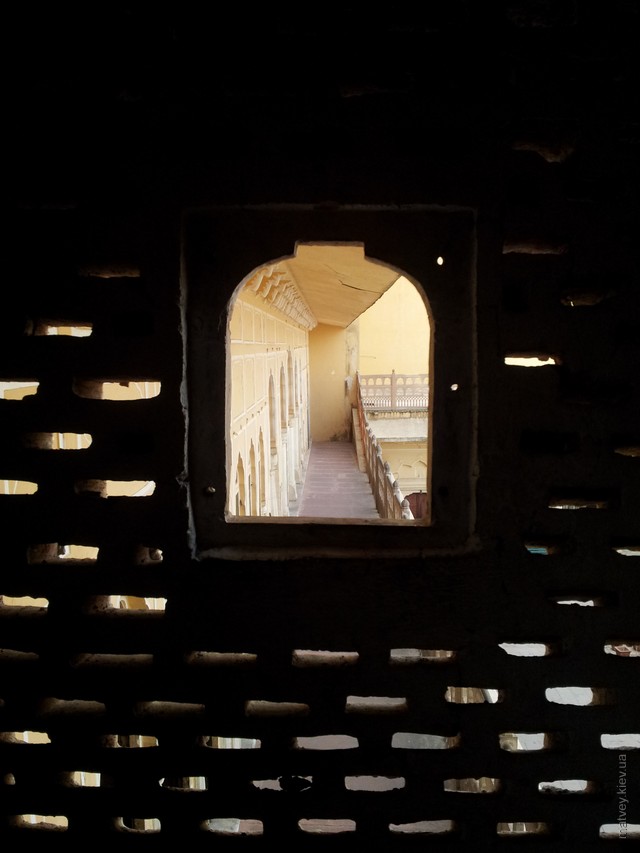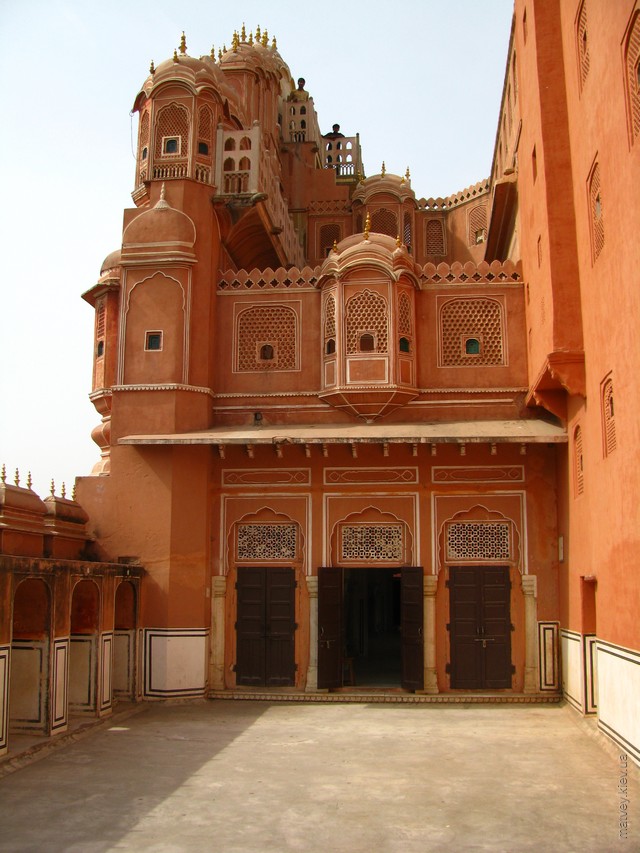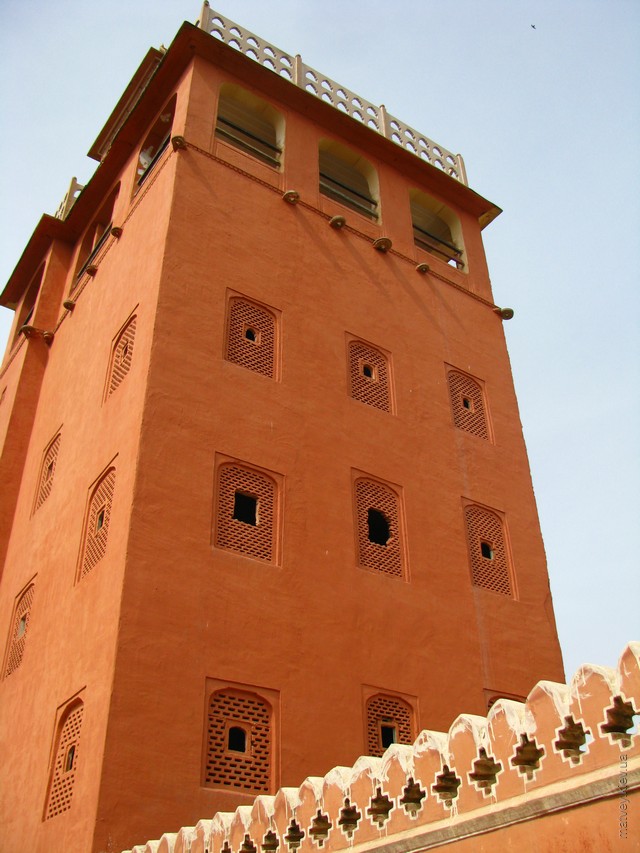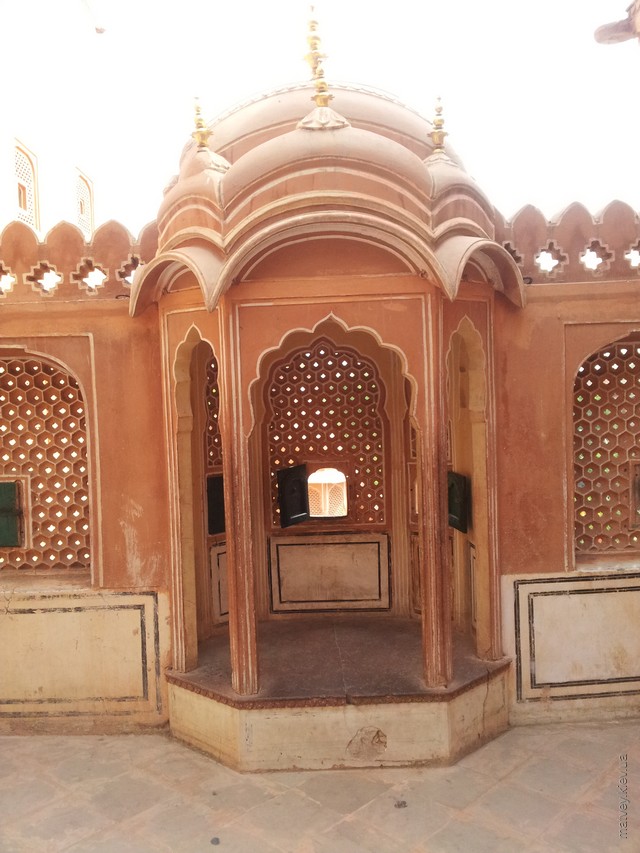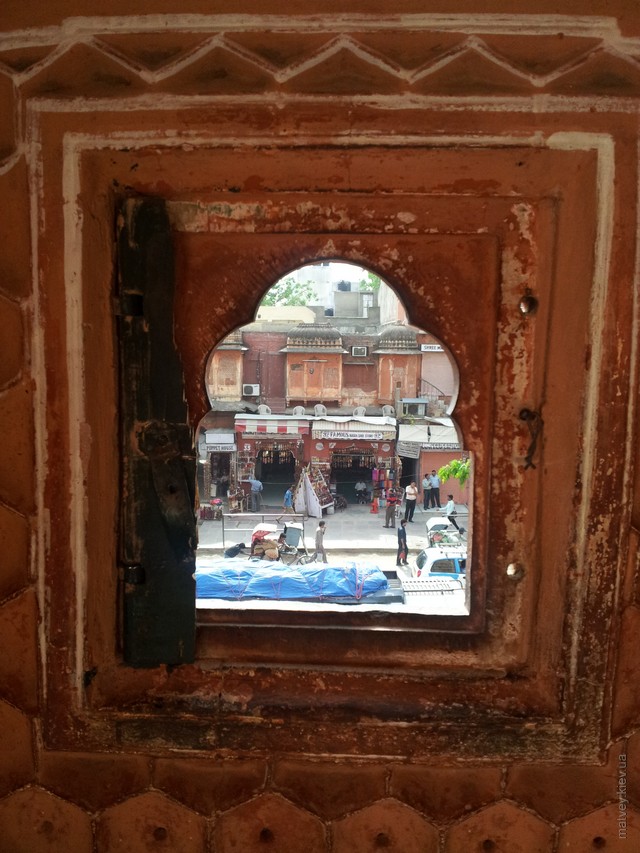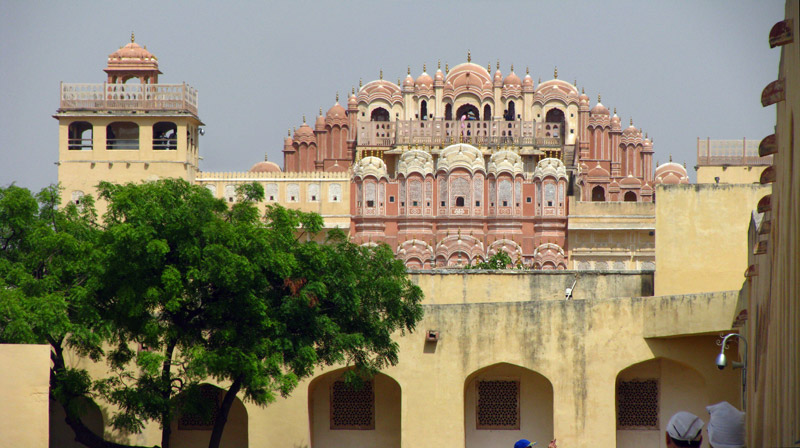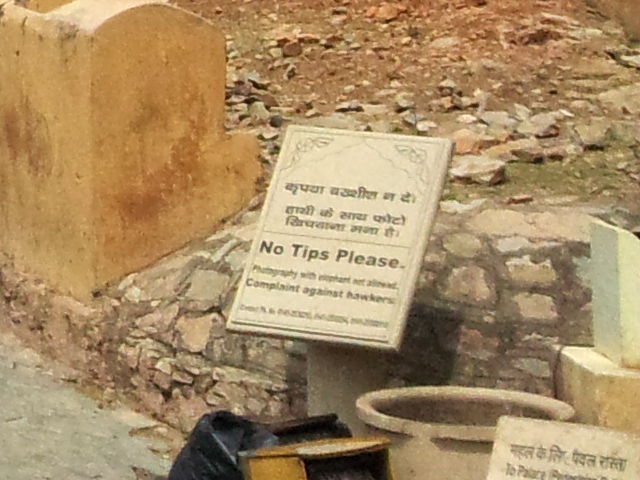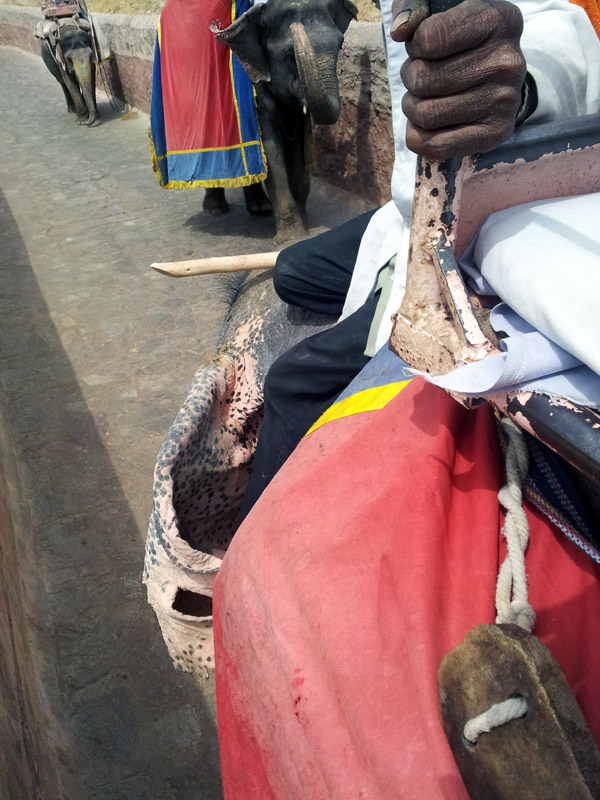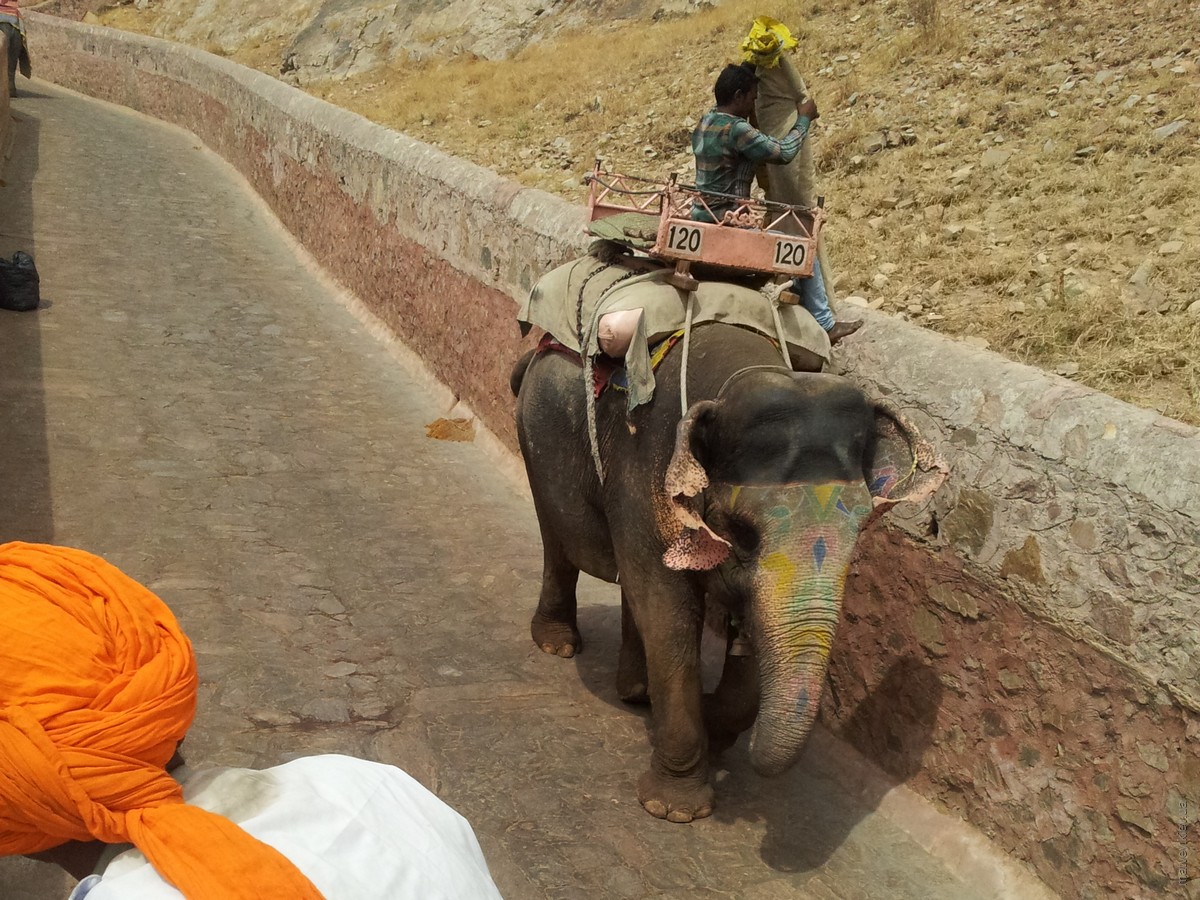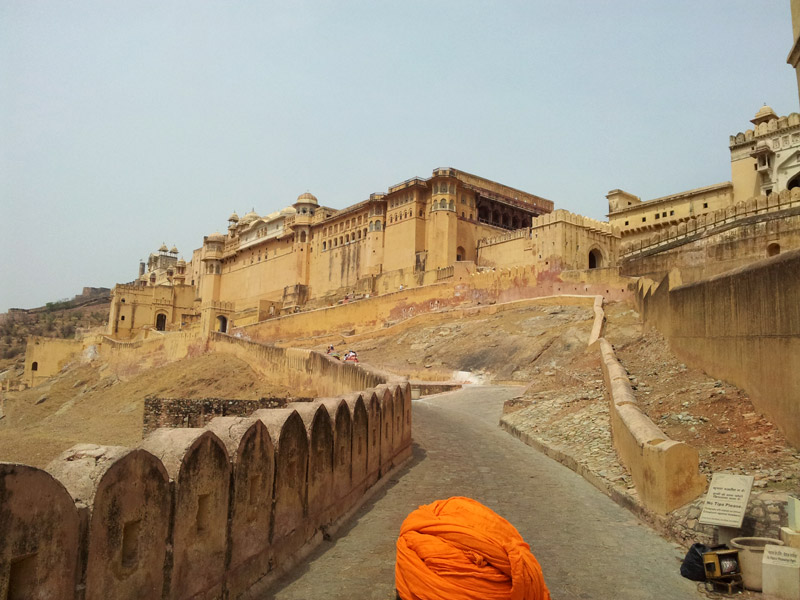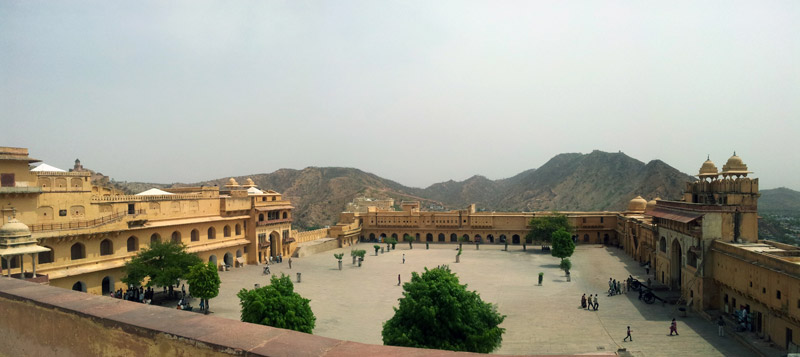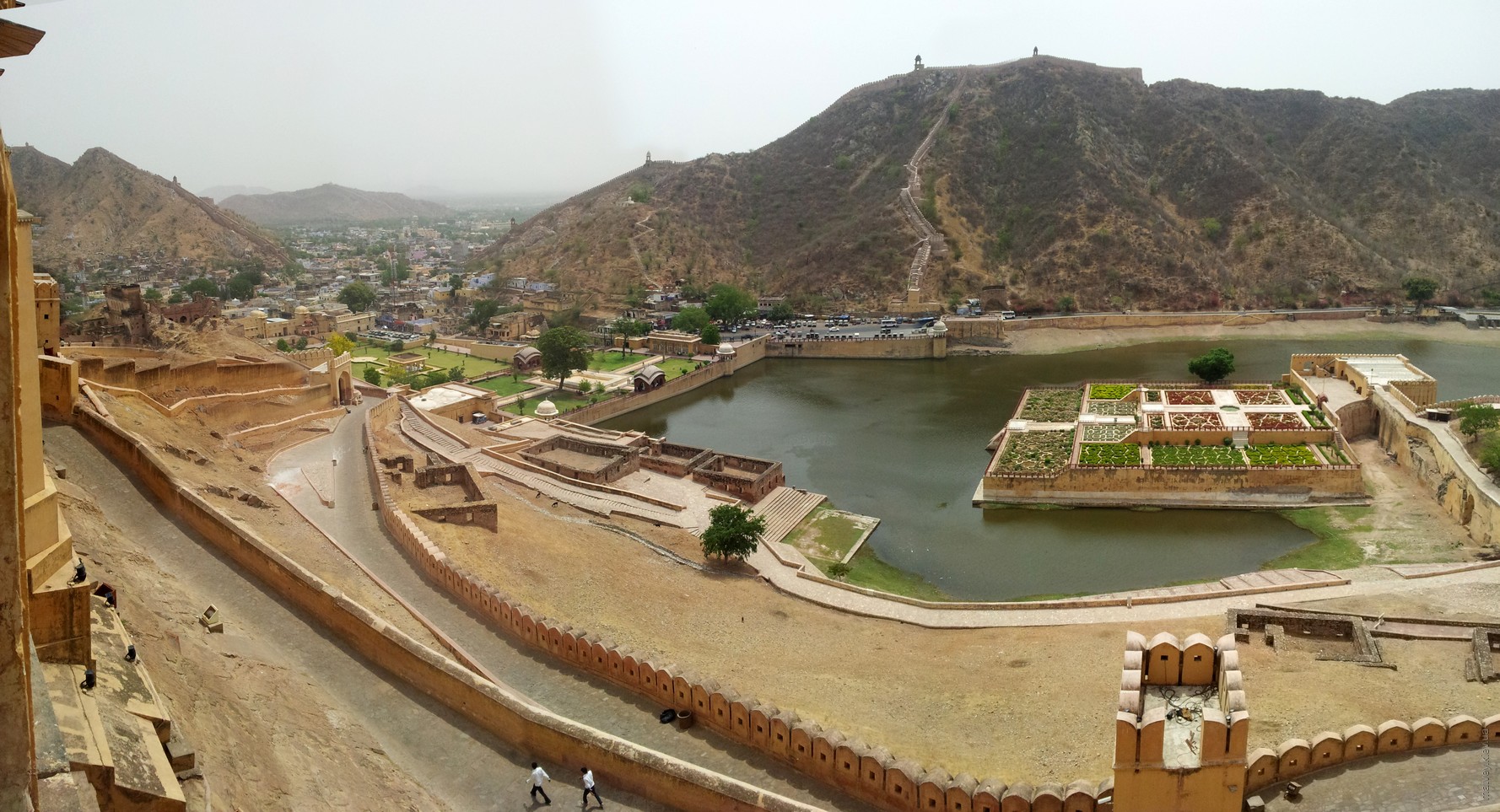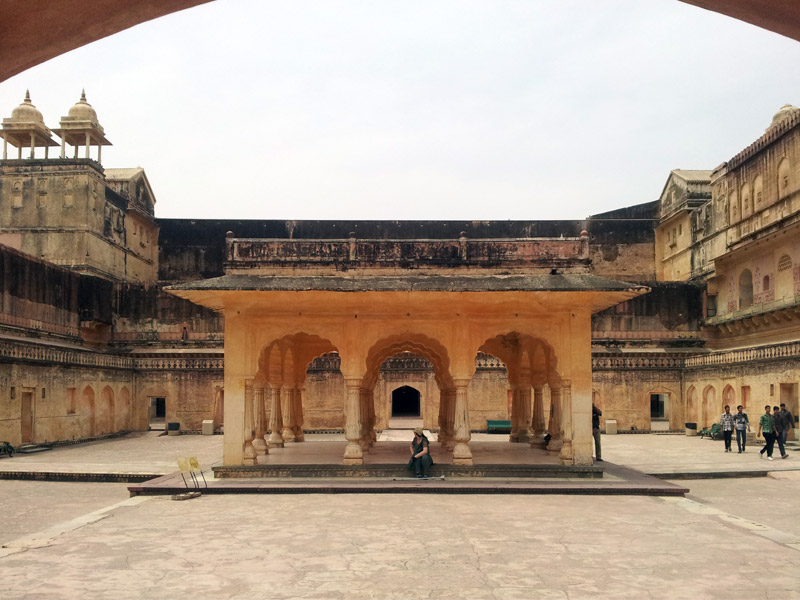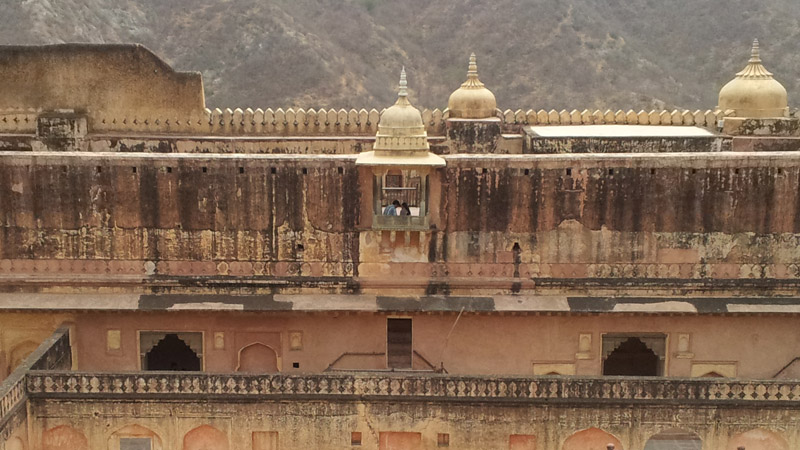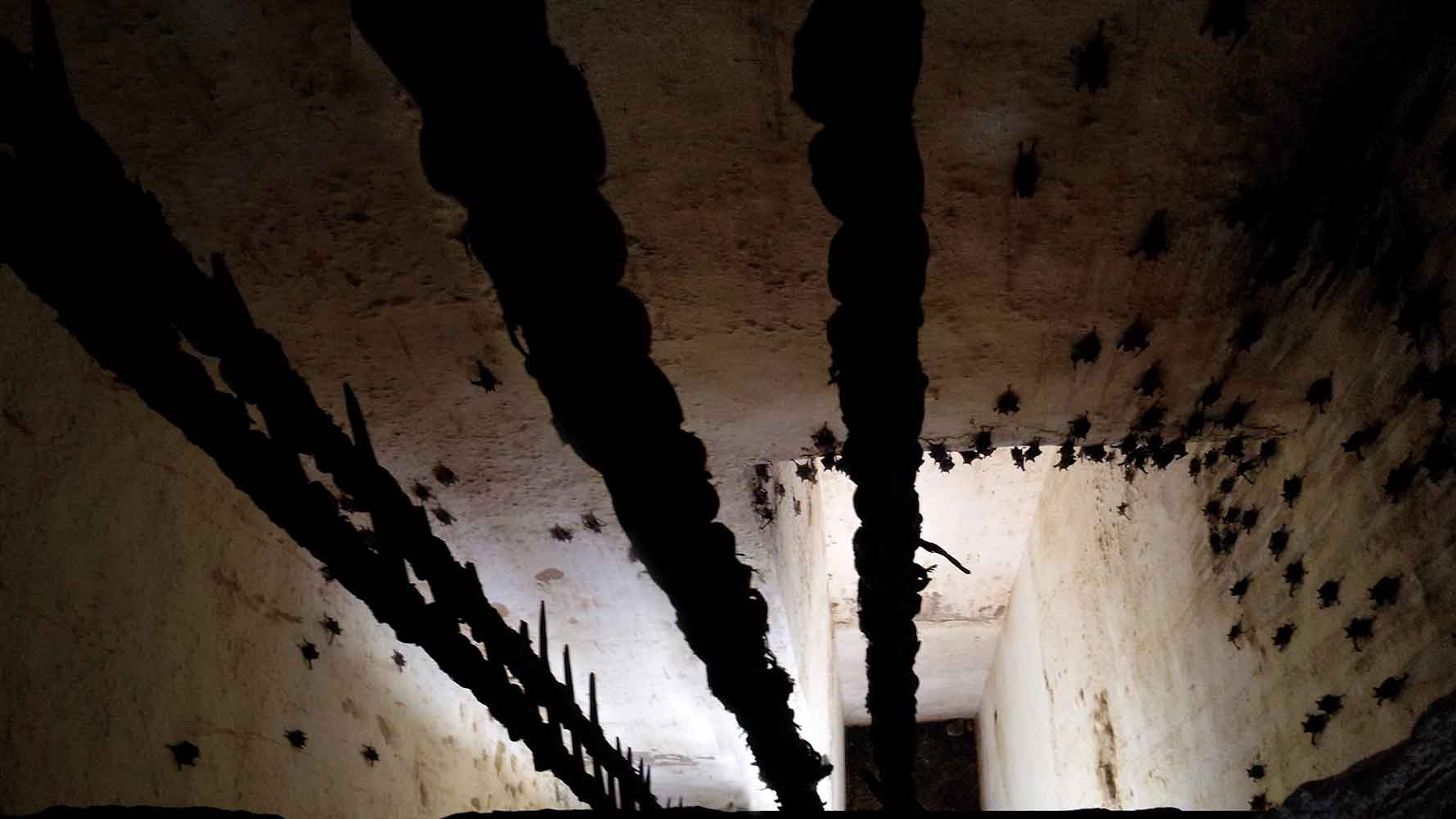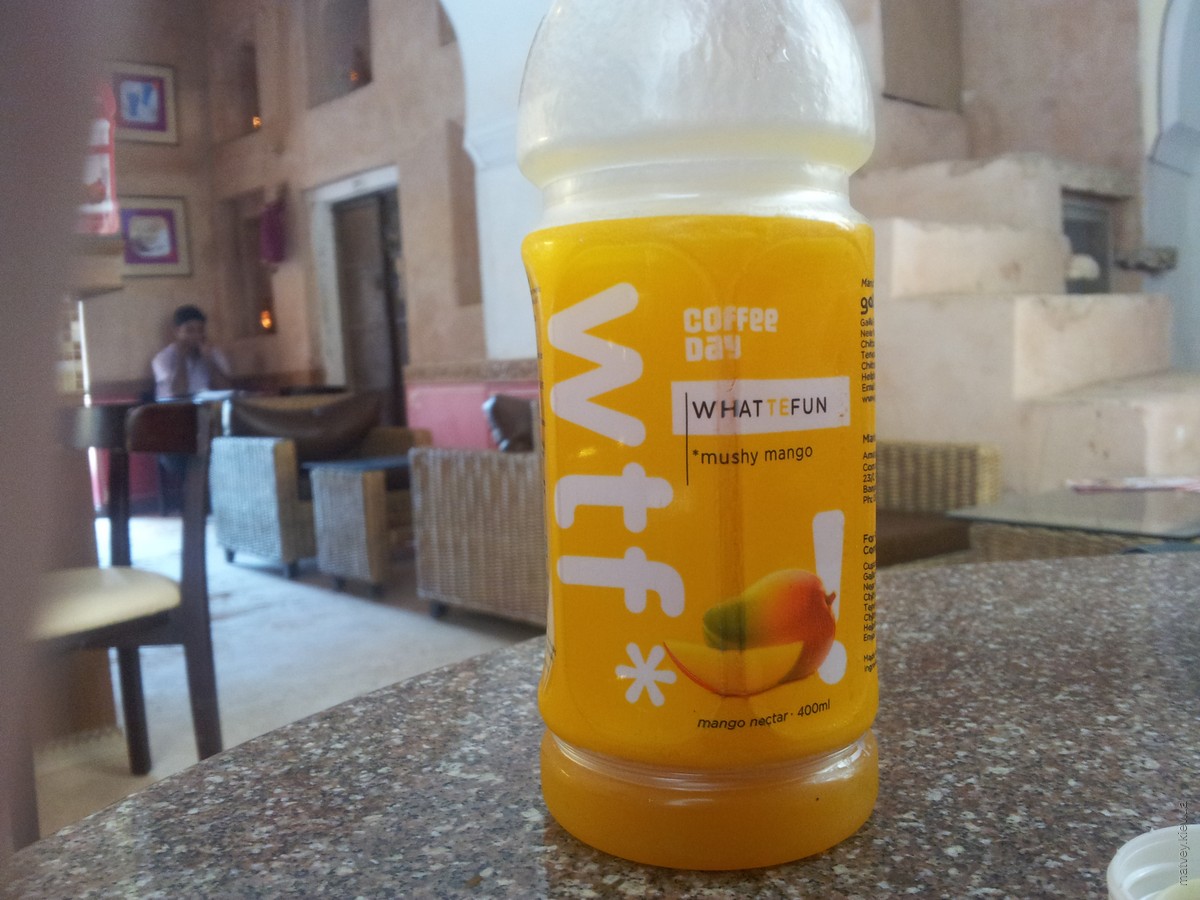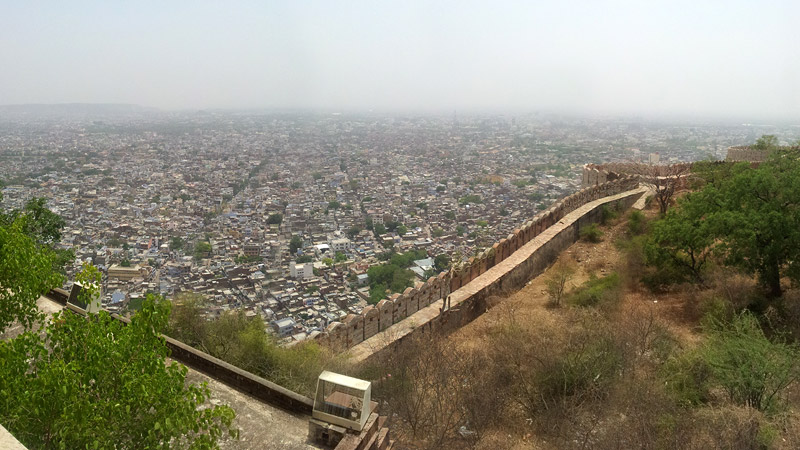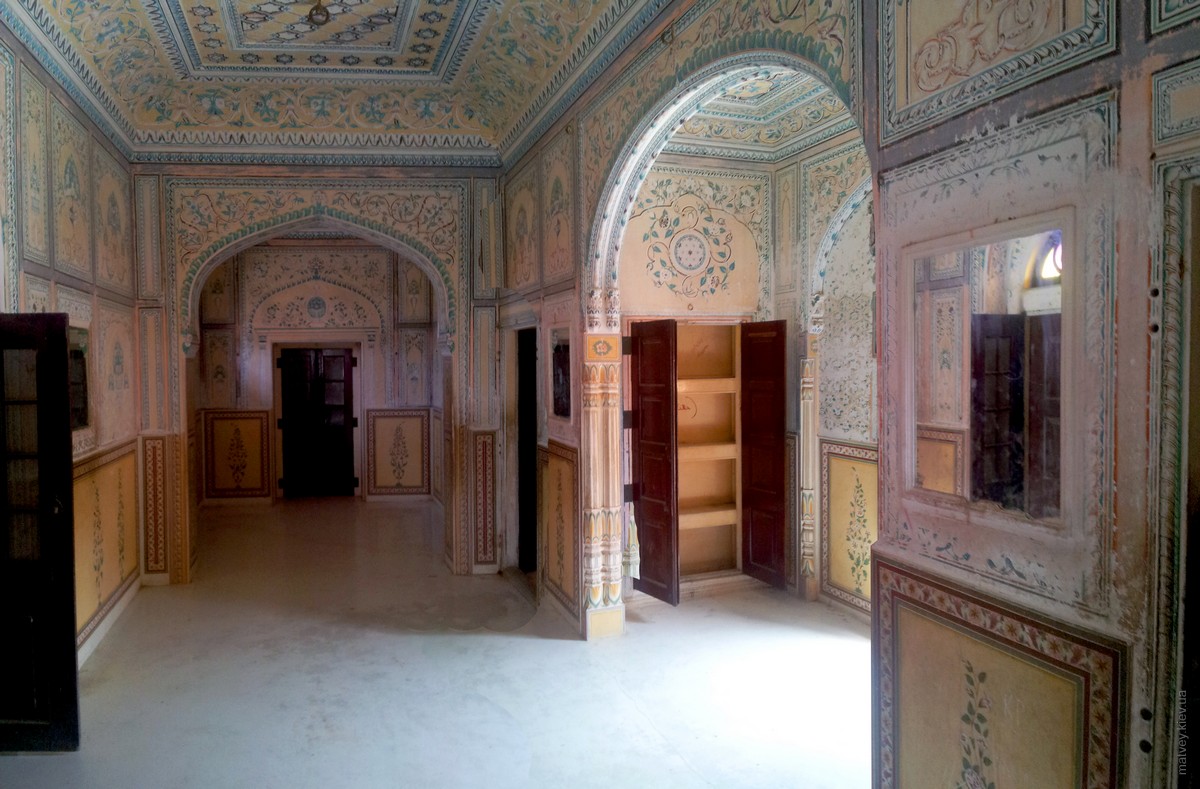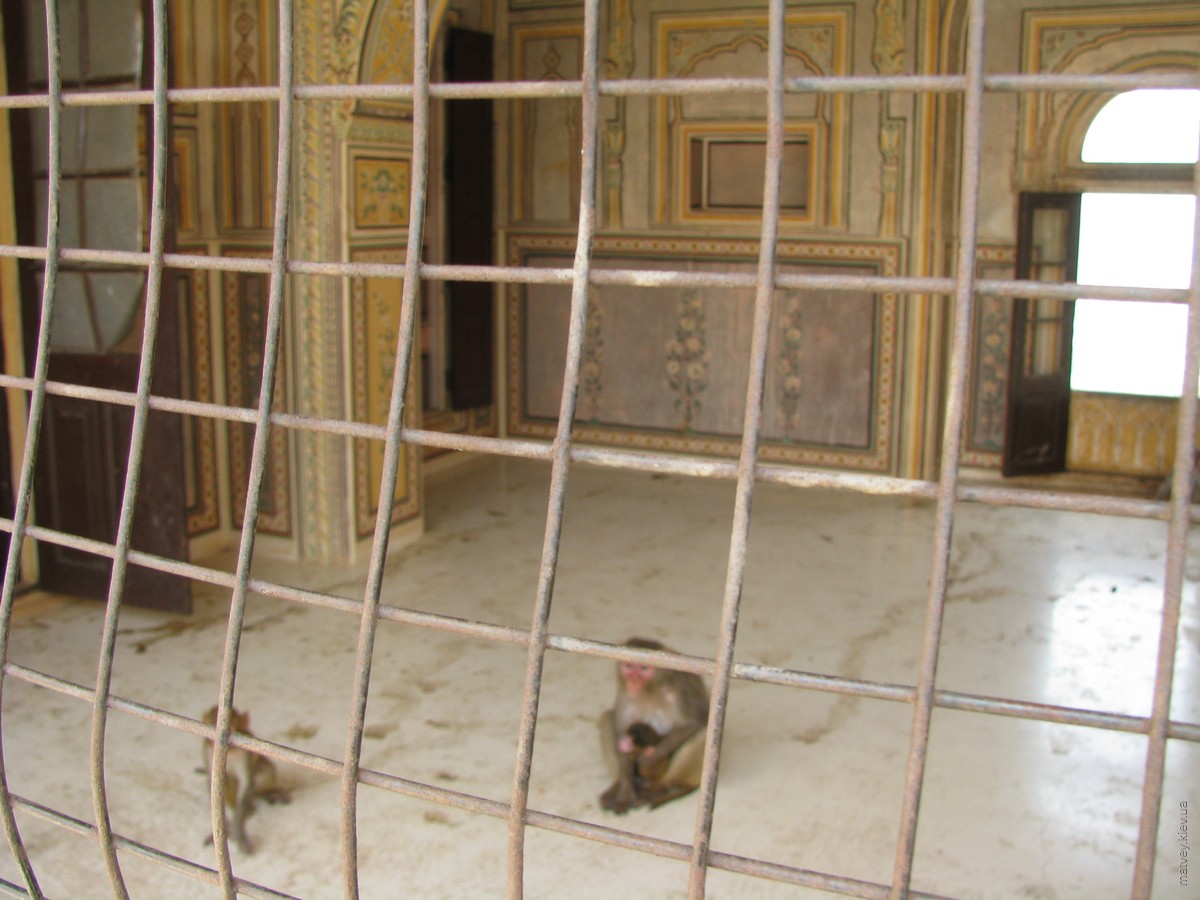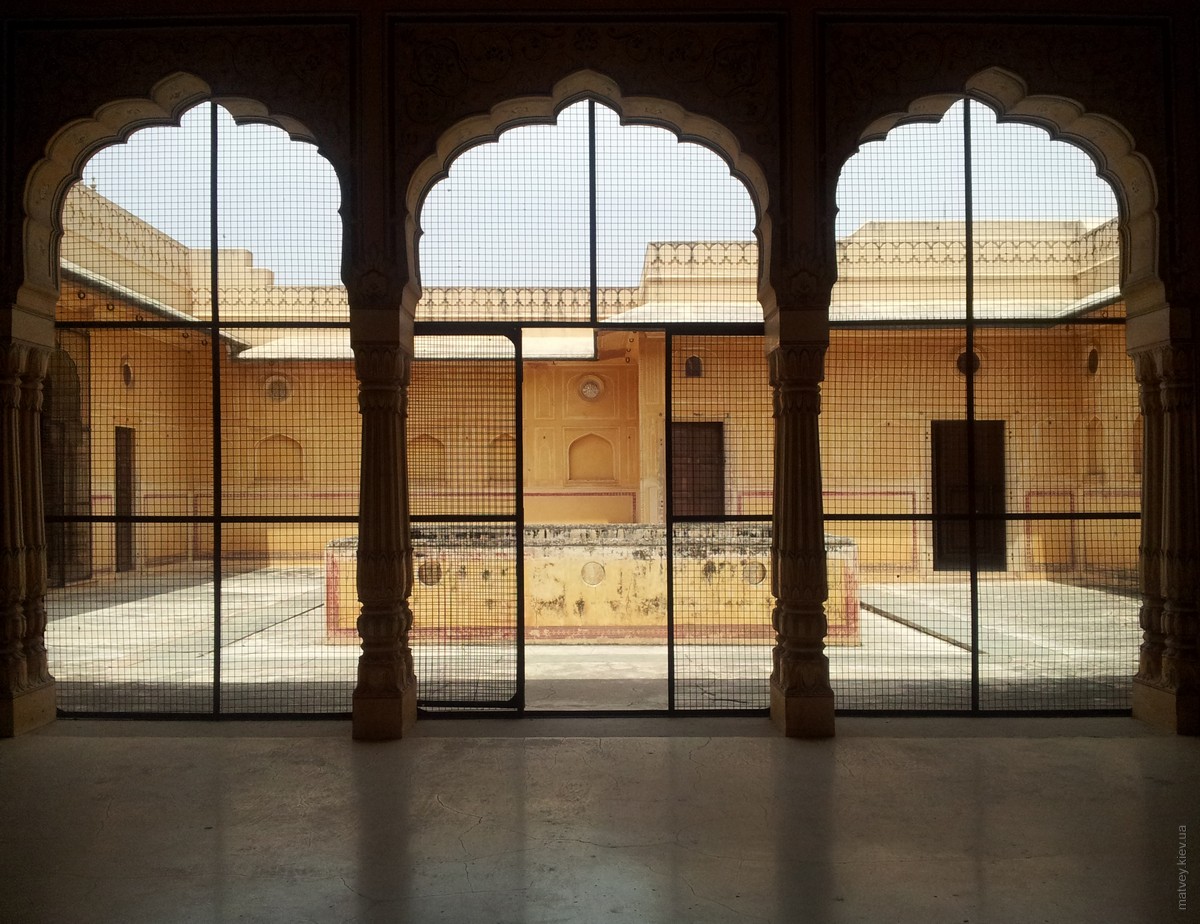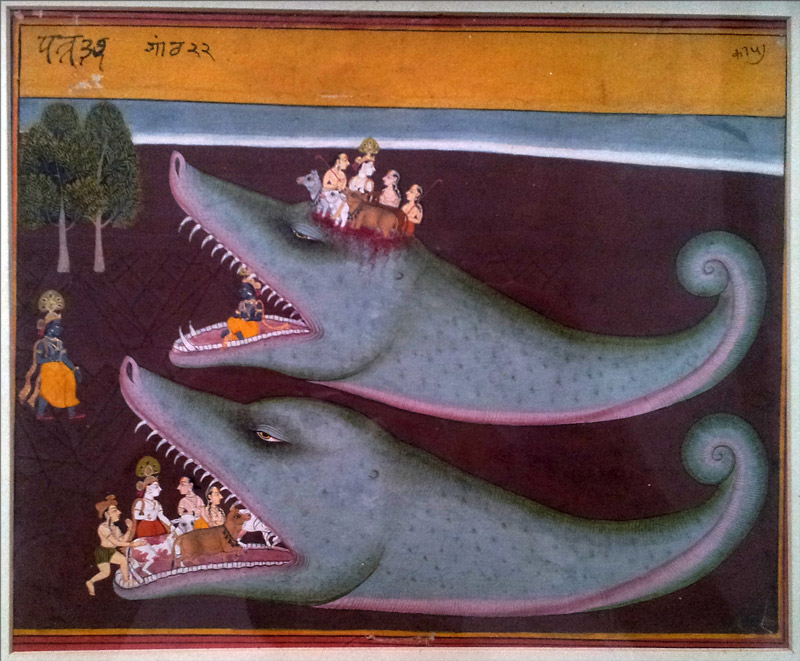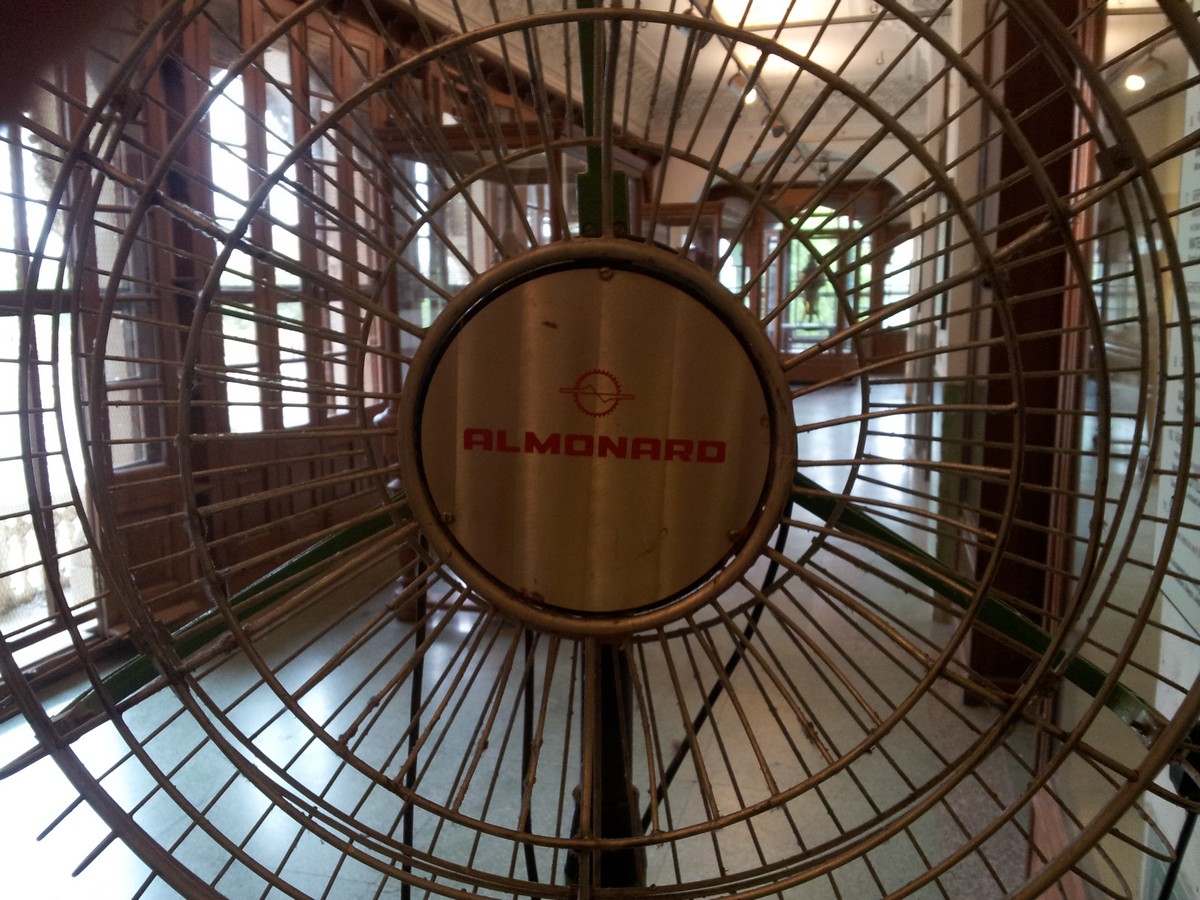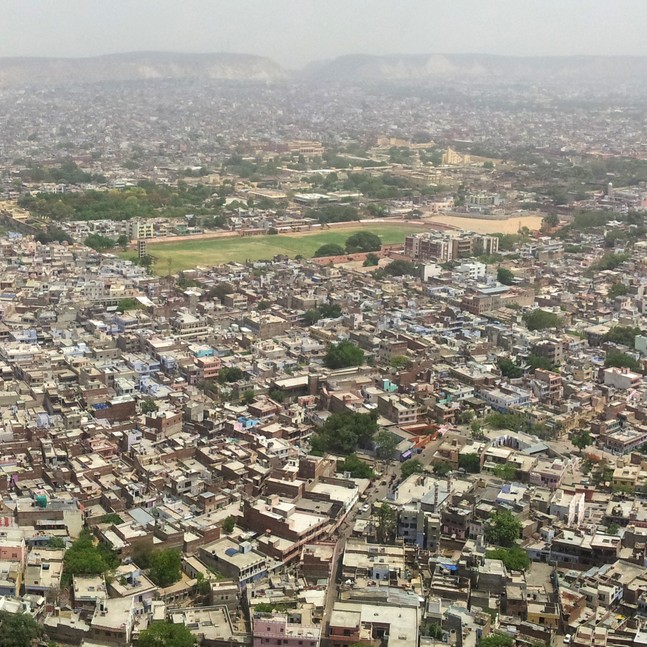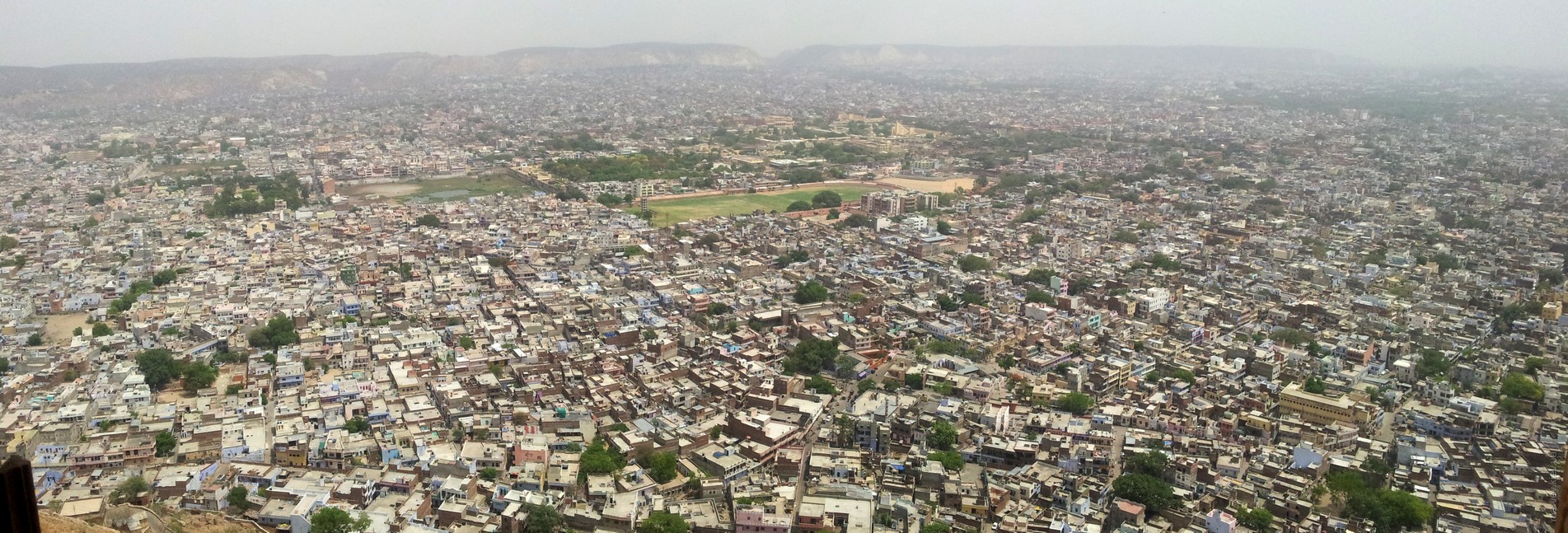Two days in Jaipur, staying in a hostel and visiting some usual tourist destinations.
After Varanasi, Jaipur turned out to be a city comfortable for us — calm and clean. We arrived to the clean, tidy train station that was not covered by day sleepers. Those who were waiting on the floor, did it in a nice way, distributing as icons on a PC desktop. There was a very tolerable amount of pesky sellers — just one person who was trying to persuade us into becoming his clients ignoring all the «no, thanks» until we passed the train station doors, where there were guards whom he respected.
We used the paid «STD ISD PCO» phones right at the train platform to call our hostel and asked for their pickup service. They sent a riksha called Imran for us, and he stayed our driver for the two days, transporting us between the least original tourist destinations for a price that did not seem low.
It was hot in Jaipur, with the lowest temperature of 30°C being at night. We were drinking water and colas all the time.
We started to satisfy the cultural pilgrimage with Galtaji, a.k.a. the monkey temple. It required some elevation gain, which was regarded to as a hard feat by someone in the internet. It was a paved pedestrian road with a couple switchbacks. Some locals on motorcycles were seen using it. The elevation gain in question was 48 meters one way and 91 meters in reverse, which is nothing if you consult any hiker friend. Here's a view from around the highest point of that road:
One of buildings of the temple. We started to meet the first monkeys.
There were many monkeys near water sources in that heat. Here's one that was using some microrelief of a vertical wall to suck a slightly leaking water tap. It wasn't just us — it was hot indeed.
More than a dozen monkeys pictured here were chilling near a pond. The closest one was their alpha male, who stayed near us all the time in case we decide to feed him, and mercilessly kicked the asses of other monkeys who tried to do the same. He doesn't look vicious, does he? His face was only imitating a humble and sad monkey.
A palace in the middle of the Man Sagar reservoir. The Indians were pronouncing it «me-HEL», also softening the last «l». We only saw it from a distance, and I do not know whether it is possible to get to the building, or how much did it cost.
A view of Jal Mahal with an Eastern great egret Ardea alba modesta, abundant here.
We bought a tourist ticket for the foreigners. It costed 300 rupees and included 4 places in this price: Hava Mahal, Amer fort, Nahargarh fort and the Albert Hall. We planned the tree of these ourselves, but did not plan the Naharga. When we told Imran the riksha about the addition of Nahargarh, he echoed with the addition of 200 rupees more, because the road up there was a relatively long one.
P.S. I think that the analog of this ticket in 2024 is called the Jaipur Darshan, is valid for two days and includes a hefty 9 places, for the new price of 1100 rupees. From my experience: two days will be not enough for nine destinations. It will require more money for transportation and will make your visits very shallow and quick — as were ours.
A tree was standing near the entrance to Hava Mahal. I guess it was a Phicus Bengalensis.
It is my understanding that this «palace of the winds» was the female section of one of palaces of one of the alpha males of this planet.
A view of one of the main streets from the Hava Mahal. The square is called Badi chaupar and the street is Johari bazaar. It would have been good to use the buses like that one instead of an overpriced riksha.
There were lots of indian visitors in Hava Mahal, travelling through their own country as we did. Almost every one of them wanted to get a selfie with a foreign woman. We complied, and it was not a one photo. More people were joining the row of complete strangers as others were leaving. I even made a photo for myself, but can't show it here due to personal catastrophes. Everyone also wanted to touch a white woman — grab a hand or put one on her shoulder. Also, the men were all wearing thick jeans, bulky sports shoes and knitted scarves in that +40°C heat.
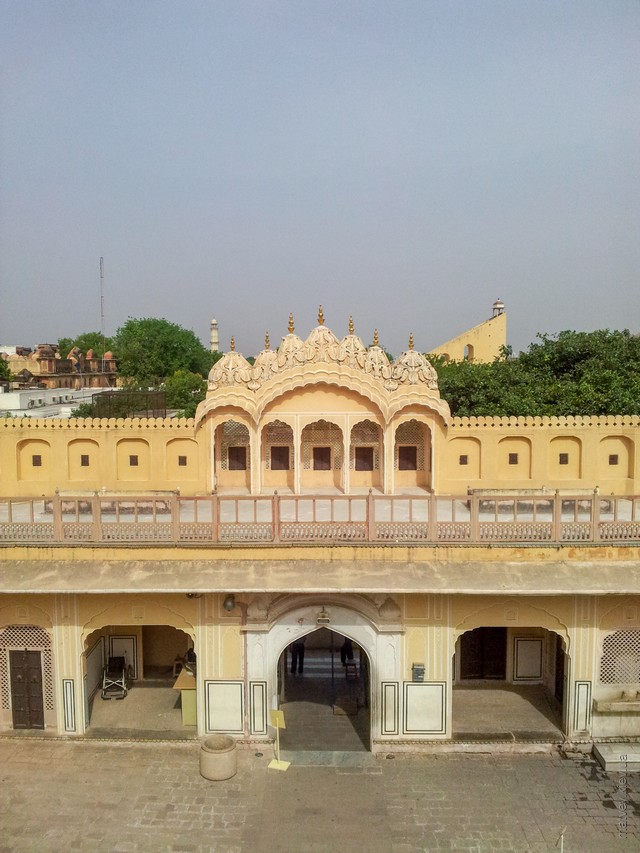 Inside the palace
Inside the palaceFrom some angles, the Hava Mahal palace resembled a multi-eyed face of a spider.
Some people are constantly trying to call this «Amber fort». It is «Amer», similar to the nearest town name. Maybe people think that more tourists will come if it is called amber, but there was already enough, including the two of us spending someone's hard-earned cash (mine).
The main objective of the Amer fort leg of our pilgrimage was the possibility to ride on the back of an elephant. It was not cheap — 900 rupees for one person. It was absolutely not interesting — we did not see or touch our elephant, because it was completely covered with thick sheets. It was slow and very short — 650 meters in 10 minutes, slower than walking! But it was obligatory after all the books we read in childhood.
There were warnings all over the fort: «No tips please. Photos with elephants are not allowed. Complaint against hawkers».
Despite these warnings, our elephant master and other people — whether official or not — were still asking for more money or were not giving the rest until asked. The elephant driver was in utter disappointment when I asked for my 200 rupees from the 2000 I gave him. I even felt sorry for him. But, unfortunately, I cannot feed everyone on this planet — only Imran the riksha!
We didn't see the elephant we were riding on, but we saw some in the oncoming traffic.
When we were planning the trip, it was hard to find the place where the elephant rides started. I only found white dots that were not like cars on satellite images. It turned out to be the white cloths that were covering the elephant backs. Now that I've been there myself, I drew the Amer fort elephant route on Google Maps.
I heard that there was one more, longer, route of elephants, but I didn't check it myself.
Amer fort is very big and interesting. I'd say that one day is needed for a decent visit.
The inner square, where the elephants arrive to. They reach the flat platform visible left of the center. That platform allowed to climb off conveniently.
This is a view down, where the elephants came from. The water body was called the Maota lake and contained the garden called Kesar Kyari. Several low but very attractive hills could be seen around the place. I bet hiking these hills actually is the best thing to do around Jaipur except cycling, but unfortunately I didn't have the time to check. Some of the Amer town can be seen between the two hills.
A square in another part of the fort.
It seemed that the architecture of Amer fort was based on a simple idea: make rectangular boxes or rectangular cuttings. Decorate the rectangles with domes and arches.
This well full of sleeping bats was, probably, the most interesting place in the whole Amer fort. Do not aske me how to get to this well — I was led by a random guy, and he made many turns. The random guy turned out to be a helper who did it for the money, but never mentioning it ahead. I gave him some amount because the bats were indeed cool and I would not have seen them if it wasn't for him, but his face was displaying discontent with that amount.
There was a pigeon in that well, not deep. It was waiting for the temperature to drop at least below +40°C, I guess.
A glimpse into Indian brands. We were hydrating with this in a little shop near the Amer fort. There was only the cashier in the shop except us — there he is outside the depth of field. He behaved himself for a few minutes, then unleashed the demons and started to ask questions about sexual life — ours or of all Ukrainians. O, India! WTF?
We had to pay 10 rupees more to enter the territory of Nahargarh despite having the tickets. Perhaps, due to the motorized riksha. This fort was much less popular than the Amer's. It is also less maintained. The building was a bit dull. There were more trees here than in the Amer fort. The Indians were pronouncing it «Naarga». There were nice views of Jaipur from a height of 112 meters. The city seemed enormous from here.
There were only us, one guard, one woman and our riksha Imran on the whole territory of the fort.
Not counting the monkeys, that is. A group of macaques was being held behind some bars in one of the corridors. Feeding was allowed; I gave them peanuts. The dominating male took all of that, and had beaten the soul out of a young monkey whom we had fed outwitting the alpha male. Nature is metal.
An inner open area inside the building.
We did not have a lot of enthusiasm left but still went to this museum. I cannot say it was interesting, unfortunately. I only recall one miniature depicting Shiva having been swallowed by a marine monster together with his friends during their peaceful walk. But the inedible Shiva had increased his size and ruptured the creature from inside. The party continued their peaceful walk after exiting through the messy hole in the monster's head.
Another only thing I recall were numerous floor fans inside the museum:
We asked Imran if he knew the meaning of his name. He didn't and asked his father, who said that his son named after a cricket player. We insisted that we wanted the meaning, like «Matvey» is «god's gift» in Hebrew. Ah, okay, he said. «Imran» also means «god's gift». We were suspicious and had to google, which produced the true meaning of the Arabic name Imran, this being «prosperous» or «happiness». Despite not knowing that meaning, Imran the riksha was trying to reach prosperity (equals happiness in our world) at our cost. His prices were bigger than they could be, and he constantly tried to take us to a carpet shop of his partners. Maybe we have changed our mind and want to step into the trouble of transporting a carpet 4500 km? No, thanks.
Jaipur, Galtaji and the nearby hills were very nice. It would be good to see them better and spend a month hiking here.
